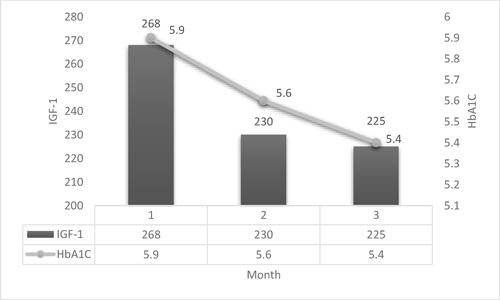ECE2021 Audio Eposter Presentations Pituitary and Neuroendocrinology (113 abstracts)
A micromegaly case: Difficult to determine whether a metabolic state or an acromegaly subset
Meliha Melin Uygur 1 & Dilek Gogas Yavuz 2
1Marmara University Pendik Training and Research Hospital, Internal medicine, division of endocrinology and metabolism, istanbul, Turkey; 2Marmara University medical school, Internal medicine, division of endocrinology and metabolism, istanbul, Turkey
Introduction:
Acromegaly is caused by excess levels of growth hormone (GH) and insulin-like growth factor 1 (IGF1), which usually result from a pituitary adenoma. At the presence of classical symptoms, the diagnosis is confirmed by increased serum IGF1 concentrations and high serum levels of GH that are not suppressed in an an oral glucose tolerance test (OGTT). A nadir GH cut-off of 0.4 µg/lwith ultrasensitive assays is considered as diagnostic. However, some patients with lower nadir GH despite elevated IGF-1 levels, also named as micromegalic, were reported.
Case
We present a case of 35 years-old woman, who got involved a clinical trial in outpatient clinic of Marmara University Medical School Endocrinology and Metabolism Deparment. An elevated IGF-1 level was detected by coincidence. The patient did not have acromegaly-related complaints. Her weight was 74 kg, height was 178 cm. Waist circumference was 92 cm. Her body mass index was 23.3 kg/m2 and his waist to height ratio was 0.51 kg/cm. In biochemical evaluation, GH level was 3.36 µg/l, IGF-1 level was 268 (63.4-223) µg/l. After an oral glucose load, GH level supressed to 0.08 µg/l. During OGTT insulin levels were recorded as 10.65, 52.53, 31.41 mU/L; glucose levels were recorded 92, 95, 85 mg/dl at 0, 60, 120 minutes; respectively. Hemoglobin A1c (HbA1c) level was 5.9%. The pituitary magnetic resonance imaging (MRI) showed a suspected 2 mm adenoma on the right side of the pitutary gland. According to the laboratory results regarding glucose intolerance, calori restriction and exercise were advised to the patient. IGF-1 and HbA1c levels decreased after life style intervention.
Conclusion
The pathologic mechanism of the discordance betwwen GH and IGF-1 in acromegaly is still unknown. Metabolic processes might be the underlying reason that was shown in a recent study which eucaloric very-low-carbohydrate ketogenic diet was useful in maintaining IGF-1 control. İn our case, it is difficult to determine whether excess IGF-1 levels were a consequence of the glucose intolerance or GH-secreting pituitary adenoma.
References
1. Melmed S. Acromegaly pathogenesis and treatment. J Clin Invest. 2009 Nov;119(11):3189-202. doi: 10.1172/JCI39375.
2. Butz LB et al. ’Micromegaly’: an update on the prevalence of acromegaly with apparently normal GH secretion in the modern era. Pituitary. 2016;19(6):547–551.
3. Coopmans EC et al. Eucaloric Very-Low-Carbohydrate Ketogenic Diet in Acromegaly Treatment. N Engl J Med. 2020;382(22):2161–2162.
 }
}



